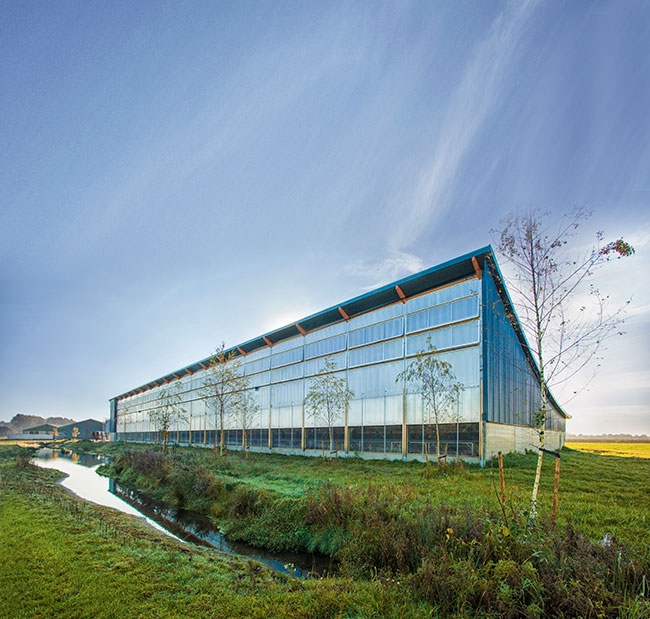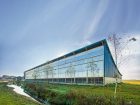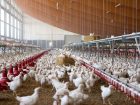
Dutch poultry stakeholders design new broiler production model
By Melanie Epp
Features Broilers Production Animal Welfare Business/Policy Environment Global SustainabilityThis new Dutch broiler concept addresses the production concerns of farmers, animal rights groups, environmentalists and government.
 The building has an open facade and a concave roof. The large windows allow for plenty of natural light while addressing the issue of transparency.
The building has an open facade and a concave roof. The large windows allow for plenty of natural light while addressing the issue of transparency. With public pressure on the Dutch agricultural sector to address issues related to environmental sustainability and animal welfare, industry stakeholders came together to design a new broiler production concept called Windstreek. The concept not only addresses public concerns, but also improves economics at the farm level.
Bram Bos, a livestock researcher from Wageningen University in the Netherlands, and Geert-Jan Camps, manager of product development and marketing from VDL Agrotech, spoke about the concept at EuroTier, the world’s leading trade fair for animal production, held in Hannover, Germany, in November 2016.
With a population of nearly 17 million people and an average population density of 412 people per square kilometre, it’s no wonder the Dutch are under pressure to come up with more sustainable production models.
By comparison, Canada has a population of approximately 36 million, but with its nearly 10 million square kilometres of land, population density, on average, is a mere 3.41 people per square kilometre. Admittedly, most Canadians live in major cities that stretch along the U.S. border, and few of them feel the density like the Dutch do. The Canadian public, however, puts similar pressures on the agricultural sector; perhaps Windstreek is a solution.
What makes this concept revolutionary is the fact that its designers spent considerable time consulting with both the public and industry stakeholders. The goal was to design a broiler production facility that would be accepted by farmers, animal rights groups, environmentalists and government bodies. The meetings, which involved 50 to 70 people, resulted in a list of objectives: to improve animal welfare, the environment, health, and farmer income, while addressing issues of esthetics.
With a lot of different goals on their plate, the next task for the designers was to figure out how to address them all. On the one side, Camps said, it was important to fulfill all of the goals and criteria, but it was equally important to make sure the farmer could still make a good living. Camps said it was “almost mission impossible.”
The future of broiler production
In the Netherlands, there has been much discussion about the effects of livestock production on the natural environment, Bos said. Closed barns, in particular, raise concerns. “Closed barns suggest that there is no transparency and that there’s something to hide,” Bos explained. “We tried to develop an alternative that would be not only accepted, but desired.”
What makes Windstreek innovative? First, it’s the building design, Camps said. The design, he explained, is attractive. The building has an open facade and a concave roof. The large windows allow for plenty of natural light while addressing the issue of transparency.
“It’s impressive from the outside, but also from the inside,” Camps said.
The building’s design also provides natural ventilation, which means farmers can cut costs by foregoing traditional ventilation systems. “Because the roof is vertically designed, we could have a ventilation system based on natural ventilation,” he said. “There’s not a fan inside. It’s high-tech computer controlled, but no fans inside.”
The concept also uses BrooDy technology, an innovative brooder canopy that uses electrical heating, inductive LED lighting, integrated drinking lines, and VDL Valenta panfeeder lines. As much as possible, the canopy creates a natural environment for the growing broilers.
The idea, Camps explained, was to create a microclimate. “We use the heat that the birds produce to create a comfortable space,” he said. “We save on energy consumption.”
The sides of the BrooDy canopy are equipped with curtains, which help to reduce the loss of energy. At the same time, it allows the birds to migrate from under the brooder into the house outside. Feed pans are red in colour, which attracts the birds to the food from day 1. Feed level can be automatically adjusted, and the pans are easy to clean, Camps said. The drinking lines can also be used as perches and they, along with the feeding lines, are height-adjustable. “For practical reasons, everything is suspended, which means it’s easy to take it out to clean it.”
The results
Windstreek, as an experiment of sorts, is five growth cycles in. Bos and his team at Wageningen have had some time to analyze the results. Financially speaking, Windstreek has been a success. The electrical system, natural ventilation and brooding hood have all led to 80 per cent less energy consumption and no direct carbon dioxide (CO2) emissions.
“The last 20 per cent could be generated through solar energy,” Bos commented. “In this respect, no fossil fuels are used. That’s a great achievement, I think.”
With regards to emissions of ammonia and fine dust, the jury’s still out. “One of the big issues in Windstreek was how to manage the litter,” Bos said. “We want to remove the litter regularly, during the rounds. The technical way to do it still has to be improved.”
Because of this technical issue, the ammonia emissions report is not ready. “Regrettably, we cannot say that it functions how we think,” Bos said. “We expect that if you remove the source of the ammonia, which is the litter in broiler production, then you remove the source of fine dust. This is particularly important in an open-air system such as this one.”
Windstreek scored better on gait and cleanliness. No hock burns were seen, and almost no footpad dermatitis was observed. Feed conversion wasn’t much different compared to traditional systems, but Bos noted the broilers they chose for production were slower growing. Mortality rates and rejection at slaughterhouse statistics were also comparable. Bos said he expects to see improvements in successive rounds.
“Welfare seems to be quite okay,” he said, noting it was, “slightly better than a traditional barn.”
All in all, Windstreek seems to be a success. Where operations have been established, the communities are happy. In fact, Bos said they’re even proud of the concept. One farmer, Robert Nijkamp of Raalte, even won entrepreneur of the year in his community for implementing the system.
Compassion in World Farming has also recognized Windstreek with an innovation award for its efforts to improve animal welfare.
Perhaps what has made this concept most successful, though, is the way in which it was developed – by taking all industry stakeholders into account.
“Because of this interactive approach, we already had farmers on board,” Bos said. “We had industry on board, we had good relations with animal rights organizations and environmental groups and good relationships with governmental bodies.”
Print this page

